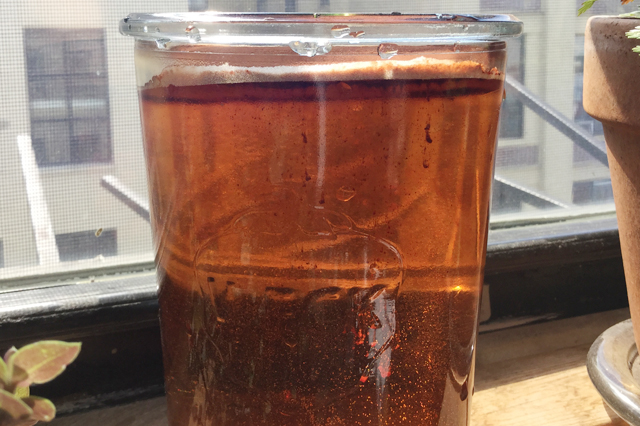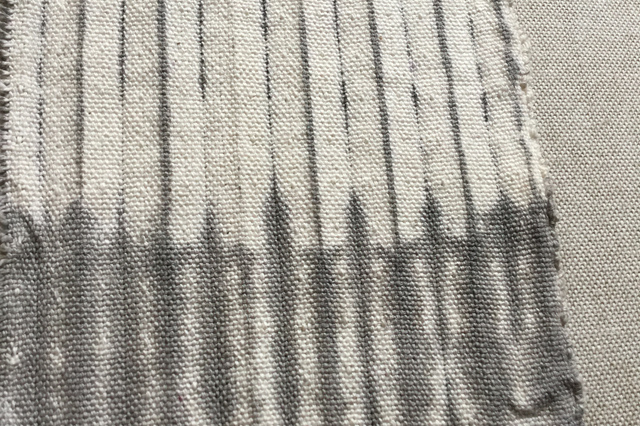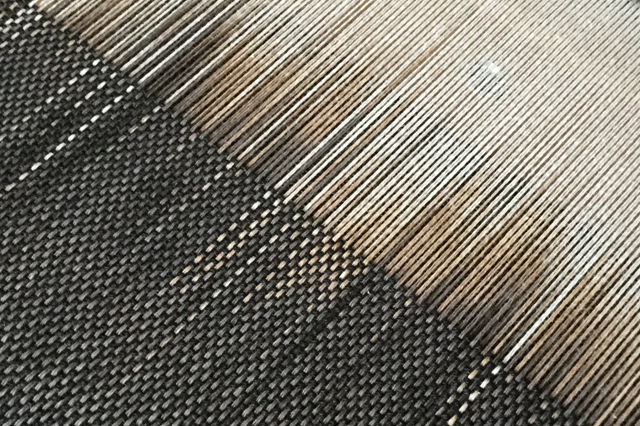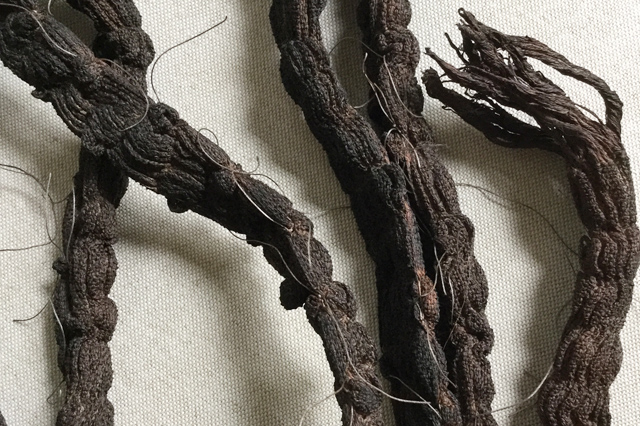My small time obsession with Kakishibu began after reading this blog. I thought I’d try my hand at combining it with indigo as it’s a frequent marriage in traditional Japanese textiles. While I don’t consider my style to be traditional at all, I do look for techniques to integrate and translate into my work. Nine months of experimenting later, I feel I’m finally getting a grip on the basics and perfecting my notes and skills enough to be of use (to me at least!).

Kakishibu is not technically a dye but more of a coating that is used in paper making, textiles, and wood work. It has a multitude of properties that I nerd out on given the chance, including it’s ability to repel water and insects along with being antibacterial. It is made from a type of astringent persimmon that is fermented and concentrated into either a liquid or powdered form. Since it’s smell is rather ripe (read: unpleasant), it can be purchased as an odorless variety if used in a small space without ventilation. While I ultimately wash what I create, I am not bothered by a smelly process if the results prove it worthwhile. Onward to the experimentation!
I began my trials by dipping bits of organic cotton and silk in this substance, working out the blobs of sticky-ness that I’d later learn can stain fabric unevenly. It takes a bit of whisking and hand mixing to work out the lumps, which can seem like blood clots. I took vigorous notes on percentages of modifying agents, namely baking soda and iron. I asked my supplier, Chris Conrad, several potentially annoying questions and scoured the book she wrote all about it. It’s nice to learn from someone with years of experience and the expertise to guide me down this path. Since natural “dyes” are so fickle, getting my hands wet with it was the only way to figure out how it works and what I want.

I was initially interested in getting that deep reddish brown color, and as always, a deep black. Along the way, shades of grey have only enhanced my work in neutral tones and made my inevitable journey into warm and cool tones a delight. Every time I see a new shade, I am reminded of a job interview years back where I showed them some iron-dyed textiles. My natural dye color palette was new and I was only beginning my journey when my color tastes were brought into question. I mentioned that my obvious love of grey came from growing up in the Pacific Northwest. That did not bode well for me. Apparently my lack of concession to bright, clean hues obliterated my chances at another job in corporate America. C’est la vie!


While working in this medium, I find the fabric becomes quite stiff upon several applications. As such, consideration must be made if you’re creating something that will have contact with your skin. I’ve found that the fabric softens up when using iron as a modifier, the amount used depends on your color preference. If you’re intent is to use the reddish-brown hue, it will probably become softer with eventual use. Either that, or you might beat it with a broom. Haven’t tried that, let me know if you do!

I find that the application to yarn and fabric yields a lovely uneven coloring, and I wouldn’t recommend this if you have the itch for a perfectly solid shade. The loveliness in Kakishibu is obtained by desiring a worn, almost hand painted look. If imperfection is your thing, you’ll love it. It may be that I haven’t tried hard enough for a solid shade, but my gut reaction to what I’ve achieved has been satisfactory and I’ve conceded to my love affair with the natural striation I’ve come to expect. As for patterning and what can be done with this “dye”…well, that’s up to you as an artist.


I have some kakishibu powder from Japan – all instruction to make up is obviously in Japanese please can you help and advise mw where I can find instruction on how to make up? I want to use it on fabric
LikeLike
Hi Carol Ann,
Chris has a pretty great book on the topic! http://www.kakishibui.com/book.html
LikeLike
Oh! How beautiful! I’m wondering though, are fabrics “dyed” with kakishibu washable? In the sense of if I would rinse it or gently soak it in slightly soapy water, would the color obtained fade or wash out completely? This is intriguing. Definitely worth a try. I’m imagining this would only work for plant-based threads/fabrics.
LikeLike
When washing woven goods, I’ve found that a little bit washes out, but not much. I suppose if your tap water has a high or low pH, that might affect the color. I use pH-neutral soap, so any slight variance isn’t noticed by my eye. Since its not technically “dyed” but rather “coated”, I believe it does bind to the fabric quite well..but does have the chance of flaking off over time. I guess I’ll have an adequate answer in 10 years about the color fastness! Also, I have been told it’s not so good on animal fibers. I did try some on testers of paper-like silk and it looks rather nice…not sure how it would hold up once woven. Give it a go and let me know what you think!
LikeLiked by 1 person